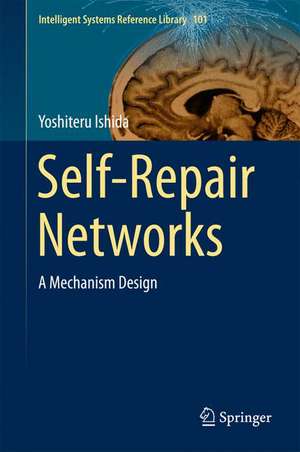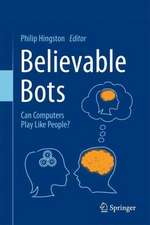Self-Repair Networks: A Mechanism Design: Intelligent Systems Reference Library, cartea 101
Autor Yoshiteru Ishidaen Limba Engleză Hardback – 6 ian 2016
The book contains interdisciplinaryresearch encompassing game theory, complex systems, reliability theory andparticle physics. All devoted to its central theme: what happens ifsystems self-repair themselves?
| Toate formatele și edițiile | Preț | Express |
|---|---|---|
| Paperback (1) | 639.72 lei 43-57 zile | |
| Springer International Publishing – 30 mar 2018 | 639.72 lei 43-57 zile | |
| Hardback (1) | 645.97 lei 43-57 zile | |
| Springer International Publishing – 6 ian 2016 | 645.97 lei 43-57 zile |
Din seria Intelligent Systems Reference Library
- 20%
 Preț: 1050.57 lei
Preț: 1050.57 lei - 20%
 Preț: 1157.60 lei
Preț: 1157.60 lei - 20%
 Preț: 648.44 lei
Preț: 648.44 lei - 20%
 Preț: 650.08 lei
Preț: 650.08 lei - 20%
 Preț: 1005.64 lei
Preț: 1005.64 lei - 5%
 Preț: 968.88 lei
Preț: 968.88 lei - 20%
 Preț: 1052.67 lei
Preț: 1052.67 lei - 20%
 Preț: 1171.46 lei
Preț: 1171.46 lei - 20%
 Preț: 1164.84 lei
Preț: 1164.84 lei - 20%
 Preț: 815.83 lei
Preț: 815.83 lei - 20%
 Preț: 989.96 lei
Preț: 989.96 lei - 20%
 Preț: 1063.41 lei
Preț: 1063.41 lei - 20%
 Preț: 504.37 lei
Preț: 504.37 lei - 18%
 Preț: 1113.26 lei
Preț: 1113.26 lei - 20%
 Preț: 1920.04 lei
Preț: 1920.04 lei - 20%
 Preț: 990.62 lei
Preț: 990.62 lei - 20%
 Preț: 651.57 lei
Preț: 651.57 lei - 20%
 Preț: 660.16 lei
Preț: 660.16 lei - 20%
 Preț: 647.13 lei
Preț: 647.13 lei - 20%
 Preț: 654.05 lei
Preț: 654.05 lei - 20%
 Preț: 649.93 lei
Preț: 649.93 lei - 20%
 Preț: 648.11 lei
Preț: 648.11 lei - 20%
 Preț: 657.99 lei
Preț: 657.99 lei - 20%
 Preț: 656.84 lei
Preț: 656.84 lei - 20%
 Preț: 1624.04 lei
Preț: 1624.04 lei - 20%
 Preț: 642.98 lei
Preț: 642.98 lei - 20%
 Preț: 649.60 lei
Preț: 649.60 lei - 20%
 Preț: 651.23 lei
Preț: 651.23 lei - 20%
 Preț: 653.06 lei
Preț: 653.06 lei - 20%
 Preț: 1002.99 lei
Preț: 1002.99 lei - 20%
 Preț: 645.14 lei
Preț: 645.14 lei - 20%
 Preț: 658.33 lei
Preț: 658.33 lei - 20%
 Preț: 644.98 lei
Preț: 644.98 lei - 20%
 Preț: 646.62 lei
Preț: 646.62 lei
Preț: 645.97 lei
Preț vechi: 807.46 lei
-20% Nou
Puncte Express: 969
Preț estimativ în valută:
123.61€ • 129.38$ • 102.88£
123.61€ • 129.38$ • 102.88£
Carte tipărită la comandă
Livrare economică 31 martie-14 aprilie
Preluare comenzi: 021 569.72.76
Specificații
ISBN-13: 9783319264455
ISBN-10: 3319264451
Pagini: 180
Ilustrații: XXII, 157 p. 50 illus., 12 illus. in color.
Dimensiuni: 155 x 235 x 11 mm
Greutate: 0.43 kg
Ediția:1st ed. 2015
Editura: Springer International Publishing
Colecția Springer
Seria Intelligent Systems Reference Library
Locul publicării:Cham, Switzerland
ISBN-10: 3319264451
Pagini: 180
Ilustrații: XXII, 157 p. 50 illus., 12 illus. in color.
Dimensiuni: 155 x 235 x 11 mm
Greutate: 0.43 kg
Ediția:1st ed. 2015
Editura: Springer International Publishing
Colecția Springer
Seria Intelligent Systems Reference Library
Locul publicării:Cham, Switzerland
Public țintă
ResearchCuprins
Introduction: Self-Action Models.- Incentives for Repair in Self-Repair Networks.- A Phase Transition in Self-Repair Networks: Problems and Definitions.- Controlling RepairingStrategy: A Spatial Game Approach.- Adaptive Capability in Spaceand Time.- Protection of CooperativeClusters by Membrane.- Duality in Logics ofSelf-Repair.- Asymmetry between Repair andInfection in Self-Repair Networks.- Dynamics of Self-RepairNetworks of Several Types.- Self-Repair Networks as anEpidemic Model.- Self-Repair Networks and theSelf-Recognition Model.- Conclusion.
Textul de pe ultima copertă
Thisbook describes the struggle to introduce a mechanism that enablesnext-generation information systems to maintain themselves. Our generationobserved the birth and growth of information systems, and the Internet inparticular. Surprisingly information systems are quite different fromconventional (energy, material-intensive) artificial systems, and ratherresemble biological systems (information-intensive systems). Many artificialsystems are designed based on (Newtonian) physics assuming that every elementobeys simple and static rules; however, the experience of the Internet suggestsa different way of designing where growth cannot be controlled butself-organized with autonomous and selfish agents. This book suggests using gametheory, a mechanism design inparticular, for designing next-generation information systems which will beself-organized by collective acts with autonomous components. The challenge of mapping a probability to time appears repeatedly in many forms throughoutthis book.
The book contains interdisciplinaryresearch encompassing game theory, complex systems, reliability theory andparticle physics. All devoted to its central theme: what happens ifsystems self-repair themselves?
The book contains interdisciplinaryresearch encompassing game theory, complex systems, reliability theory andparticle physics. All devoted to its central theme: what happens ifsystems self-repair themselves?
Caracteristici
Focuses on self-repair networks which originated as an extension of Immunity-based Systems Presents a game theoretic approach to networks with special focus on mechanism design by selfish agents Presents logics, dynamics and applications of Self-Repair Networks Includes supplementary material: sn.pub/extras


















